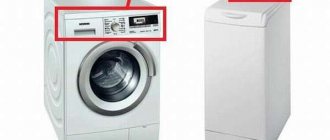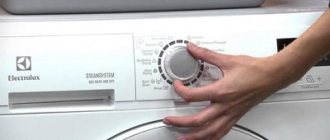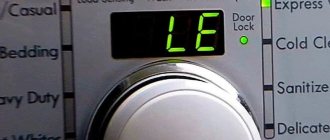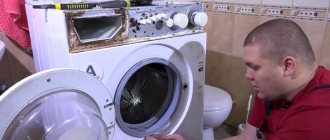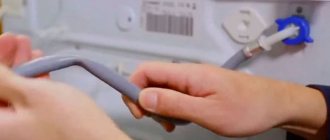Modern automatic washing machines, regardless of the manufacturer (Samsung, LG, Indesit, Bosch, Ariston, Candy, etc.), are designed almost the same. Some models have a number of design features based on engine type, loading method and the presence of additional functionality. Having an understanding of the structure of the washing machine, the location of its main components and the operating principle of individual elements, you can not only carry out minor repairs yourself, but also prevent various breakdowns. In this article we will talk about how an automatic washing machine works, look at the diagrams and understand the technical features of different types of units.
A modern automatic washing machine has a complex technical device
Components of the “vertical”
To get acquainted with the washing machine, you need to know all its components. Only by studying the names and purposes of the main components can one grasp the relationship of structural elements and their location. So, each “vertical” necessarily has the following details:
- electric motor;
- washing tank;
- metal drum with doors;
- drainage pump;
- rubber pipes and hoses;
- drum pulley;
- drive belt (if the washer does not have direct drive);
- powder and gel tray (also called powder receiver and dispenser);
- shock absorption system (springs, vibration absorbers);
On vertical washing machines, things are loaded through the top lid!
- tubular electric heater (TEH);
- drain filter;
- control board (control module);
- dashboard;
- snail;
- thermistor;
- counterweights;
- electronic lock (UBL);
- inlet valve;
- cuff;
- pressure switch (water level sensor).
All components of the washing machine are “hidden” in a metal case. There is a “tidy” and a hatch cover on top, and blank panels on the sides. A tray is often attached to the bottom of the machine.
To check the machine and troubleshoot the problem, names alone are not enough - you need to know the device, the operating principle and the location of the parts. Let's look at the components in more detail.
Design
The main design feature of vertical washing machines, as is clear from the name, is the vertical location of the hatch for loading laundry. These devices do not have a transparent loading hatch in the front.
There are models where a special mechanism is used to regulate the drum to stop it after the end of the wash. These devices are called drum parking systems.
The second difference between vertical models is two symmetrically located drums and shafts on both sides, on which it rotates. Front-facing samples have one shaft rotating the drum on the rear side, since laundry is loaded into it from the front side.
Laboratory studies of companies producing both types of washing devices show some advantage in reliability and service life of vertical washing machines due to two shafts instead of one for front-facing models.
The control panel for vertical samples is standardly located at the rear of the top cover.
Standard dimensions of top-loading devices: height – 85–90 cm, depth – 60 cm, width – 40–45 cm.
The amount of laundry that can be loaded into a top-loading machine is determined by standard rules common to all types of devices from any manufacturer. There are minimum and maximum loads, measured in kilograms.
The minimum load of 1 kg is determined based on the need for uniform distribution of laundry throughout the drum at high spin speeds to level out unwanted excess vibrations. The maximum load – 10 kg and above is limited by the dimensions of the device.
Typical household washing machines have a load capacity of 5–7 kg.
Machine control center
Most modern washing machines have electronic controls. Unlike the “old” mechanics, everything here is performed and regulated by a module - a connecting unit consisting of sensors, conductors, tracks and microcircuits. The system works as follows:
- the user sets the cycle settings by pressing buttons or rotating the programmer on the dashboard;
- the control board records the selected parameters and issues a command to execute the program;
- the necessary system nodes are turned on;
- the wash starts.
It is the control module that starts the washing machine: it processes information from the dashboard and transmits commands “through the chain” to the destination. Turning on the equipment, drawing water, accelerating the engine, draining - all this is performed only after “permission” from the electronic unit using a variety of triacs, sensors and contacts. Afterwards, the board controls the progress of work, monitoring the signals and data coming from the nodes. In the event of a failure or deviation, the device detects the problem and urgently shuts down the cycle.
It is not recommended to test and solder the board at home - it should be checked and flashed by specialists!
If there is a failure in the electronics system, the machine stops working: it does not turn on, does not respond to user commands, or freezes. It is difficult to find the problem, since either a separate track or the entire control unit as a whole could fail. In any case, the board loses control over the washing machine and, for security reasons, does not allow startup.
An electronic module is an extremely complex part. It is quite difficult to figure out on your own how it works and functions, especially for people far from electrical engineering. It’s better not to take risks and if you suspect a board malfunction, immediately contact a service center.
Principle of operation
First you need to load the laundry into the washing machine and select the appropriate washing program. The operation of the technique involves several stages:
- Soak. When the program starts, the washing process starts. The machine is filled with water to the required level. The dispenser dispenses the required amount of detergent and mixes with water.
- Start of operation of the electric motor.
- Drain and spin. New tank filling. Rinsing.
- Drain and spin. Repeats several times.
- Final spin. A signal is sent to the “brains”, which unlock the door.
Parts responsible for clean water
The filling system in a vertical washer is represented by a pressure switch, hoses and an inlet valve. Water intake begins immediately after the user starts the program by pressing the “Start” button on the dashboard. The drum is filled according to the following scheme:
- the board receives a signal about the need for filling;
- pressure switch – water level sensor, measures the pressure in the tank and signals the level of filling;
- the module makes sure that there is no water in the tank and sends a dialing command to the valve;
- voltage is applied to the intake valve, its membrane is activated, the flap rises;
- water from the water pipe flows into the machine through the inlet hose;
The pressure switch has a long tube that goes down into the tank and measures the pressure in it.
- the pressure switch controls the volume of water;
- when the required volume is reached, the pressure switch signals the unit;
- the module cuts off the current supply;
- the valve membrane closes;
- recruitment stops.
All elements of the filling system constantly interact, and the main “controller” is the water level sensor. Thanks to it, the tank is filled to a certain level, which prevents underfilling or overfilling.
Difficulties in disassembly during repairs
Features and nuances for self-repair of vertical units:
The device contains the same elements (pressure switch, water intake valve, drum, tank, control board, pump, and so on). The drum axis is structurally made on two bearings; a self-positioning sensor is sometimes located on the tank (the drum is fixed with the flaps up).
We will show the dismantling of components using the example of Electrolux:
1. Using a screwdriver, release the control panel from the sides 2. Pull the plastic panel up and slide it towards you 3. Tilt it at a slight angle towards you to remove the wires from the board connectors 4. Remove the panel
To remove the electronic control module, disconnect the remaining wires and unscrew the screws shown in the figure. For quick and correct assembly, take photographs of the connection points of the wire loops. To remove the water fill valve, disconnect the rubber hoses from the clamps and dismantle them. Unplug the wires and press on the holes from the outside to press out the valve.
To remove the side panels, unscrew several screws; do not forget to save the washers for grounding the case. Bend the wall from below with your hand and slide it down.
After removing the two sides, access to the screws for removing the front panel appeared. Unscrew them.
To remove the NTC sensors and position the DSP drum itself, it is enough to remove the right wall and dismantle them.
Many “craftsmen” sin that the control module is to blame for everything. But no!
It is enough to unscrew two bolts from the back and remove the control panel.
This very cracked handle is the culprit. Use a metal ring (antenna plug for example).
By squeezing the plastic handle, the ring will prevent programs from skipping.
There is an opinion that two drum supports instead of one are good.
This is not so, and in the case of the “vertical” it is simply a forced engineering decision. The service life of the drum bearings does not increase even by a minute.
If the screws are difficult to unscrew, heat them with a blowtorch.
On the Kandy, in order to change the bearings, you need to disassemble the entire machine down to the screw! And what about the wild cramped conditions in the depths of the “verticals”. Sometimes you have to do everything literally by touch.
Source
"Heart" of the machine
The “heart” of a washing machine is its engine. It is the electric motor that accelerates the drum shaft, ensuring rotation of the cylinder at the desired speed. The number of revolutions is controlled by a tachogenerator, which clings to the engine and constantly monitors the pace, eliminating chaotic rotation and sudden changes in direction.
The driving force is an electric motor. Modern vertical machines are equipped with inverter motors, which are connected directly to the drum shaft, without the use of a drive belt. This system eliminates “middlemen”, which makes unwinding the cylinder more efficient, reliable and safe.
Some top-loading washing machines have commutator motors. Here the impulse from the motor is transmitted to the drum through a drive belt wrapped around the pulleys. This option is cheaper, but more unreliable: the elastic often falls off, breaking or stretching. The second disadvantage is the electric brushes, which during operation of the machine wear off on the engine body and periodically need to be replaced.
Where does the hot water come from?
As with front-mounted automatic machines, on vertical units a tubular electric heater – heating element – is responsible for heating. Once the user selects a mode and adjusts the temperature, the electronic board accepts the parameters and starts the heater. The part receives the signal, and upon completion of filling, its “spiral”, brought into the tank, begins to heat up.
To avoid overheating of the heating element, do not run three high-temperature cycles in a row!
The degree of heating is monitored by a thermistor - a temperature sensor. It looks like a metal tube and is located in the heating element itself. When the set degrees are reached, the device signals the module, which turns off the heater.
Weights and shock-absorbing system
When the drum unwinds, centrifugal force inevitably appears, which is absorbed by shock absorbers. They compensate for outgoing vibration, preventing the equipment from “jumping” around the room and hitting the wall. The stability of the washing machine is ensured by the following details:
- dampers - vibration dampers with a built-in spring, connecting the washing tank to the machine body;
- springs - the tank is suspended from the top and sides;
- counterweights are concrete blocks that are attached to the bottom or sides of the vertical, weighing down the entire structure.
The shock absorption system takes on the entire “shock”. Due to constant vibration, dampers wear out, springs stretch, and counterweights become loose. Especially if the washing machine is not installed correctly or has been used for too long. In this case, it is necessary to tighten the fixing bolts and replace worn components.
Video
We offer you to watch a video on the topic of the article:
She graduated from the author's physics and mathematics lyceum and art school. Received a higher education in economics with a major in innovative management. Freelancer. Married, actively travels. He is interested in Buddhist philosophy, enjoys transurfing and loves Mediterranean cuisine.
Found a mistake? Select the text with the mouse and click:
If your favorite things show the first signs of gestation in the form of untidy pellets, you can get rid of them using a special machine - a shaver. It quickly and effectively shaves off clumps of fabric fibers and returns things to their proper appearance.
Before removing various stains from clothing, you need to find out how safe the selected solvent is for the fabric itself. It is applied in a small amount to an inconspicuous area of the item from the inside out for 5-10 minutes. If the material retains its structure and color, you can move on to stains.
The habit of using an automatic washing machine “sparingly” can lead to the appearance of an unpleasant odor in it. Washing at temperatures below 60℃ and short rinses allow fungi and bacteria from dirty clothes to remain on internal surfaces and actively multiply.
Stretch ceilings made of PVC film can withstand from 70 to 120 liters of water per 1 m2 of their area (depending on the size of the ceiling, the degree of its tension and the quality of the film). So you don’t have to worry about leaks from neighbors above.
The easiest way to remove scale and carbon deposits from the soleplate of the iron is with table salt. Pour a thick layer of salt onto the paper, heat the iron to maximum and run the iron over the salt bed several times, applying light pressure.
There are special traps to combat moths. The sticky layer with which they are covered contains female pheromones that attract males. By sticking to the trap, they are eliminated from the reproduction process, which leads to a decrease in the moth population.
Fresh lemon is not only suitable for tea: clean dirt from the surface of an acrylic bath by rubbing with half a cut citrus, or quickly wash the microwave by placing a container of water and lemon slices in it for 8-10 minutes at maximum power. The softened dirt can simply be wiped off with a sponge.
Threads made of gold and silver, which were used to embroider clothes in the old days, are called gimp. To obtain them, the metal wire was pulled for a long time with pliers to the required fineness. This is where the expression “to drag out the rigmarole” came from - “to do long, monotonous work” or “to delay the completion of a task.”
The dishwasher cleans more than just plates and cups. You can load it with plastic toys, glass lamp shades and even dirty vegetables, such as potatoes, but only without using detergents.
Source
Lock and seal
Each vertical is equipped with both mechanical and electronic. The mechanics are activated when the door is closed normally, when the locking “tongue” falls into the corresponding groove. The electronics turn on automatically when the washing program starts due to the UBL - blocking device. Thanks to the latter, the user will not be able to open the drum after the cycle has started.
The seal of the hatch is also responsible for the tightness of the drum - a rubber seal stretched over the edges of the cylinder. It closes the gap between the tank and the body, preventing leaks and clogging of the structure. If the rubber band is damaged, do not start the wash, as water will begin to leak out.
What drum parameters should be considered when purchasing washing equipment?
Before purchasing, you must carefully inspect the product:
- The fixation of the tank and drum must be reliable, since the structure should not swing much when moving. Otherwise, the internal parts may be damaged during washing.
- The surface of the drum and strikers must be smooth and polished, without nicks.
- There should be no chips or dark areas on the drum.
- The assembly quality should be at a good level: the bolts should not protrude, the crosspiece should be installed correctly.
Electric pump
A mandatory stage of any program is draining. To empty the tank, the machine is equipped with pipes, hoses, a pump and a drain filter. The key element of the drainage system is the pump, which pumps waste liquid from the drum into the sewer.
Vertical pumps are equipped with two types of pumps:
- synchronous;
- asynchronous.
Each pump is designed the same. The device is started by a motor, which accelerates and spins the impeller - a screw that gives the water the desired trajectory. The pump is fixed to the cochlea, and a drainage hose and pipes are connected to it to drain the fluid.
The garbage filter protects the washing machine from clogging - most of the debris and dirt settle on its spiral!
Problems with pumping water rarely occur, and are not the fault of the pumps. The main reason for difficult drainage is that the hoses are clogged with debris that has gotten into the washer. The drainage filter suffers the most, where dirt settles and foreign objects get stuck. For prevention, you need to check the pockets and periodically clean the nozzle and all elements of the drain system.
Main tanks
The key element of the washing machine is the tank - a sealed plastic reservoir. It is tap water that is mixed with the powder. On vertical machines, the tank is positioned with the hole facing up, and on front ones – forward.
The drum is made of stainless steel. Clothes are placed in the cylinder, then the motor spins it to a predetermined speed. It is smaller, has perforated walls and rib punches - plastic blades that “mix” things and foam the powder.
The drum volume varies from 3.5 to 15 kg and depends on the capacity of the machine.
Hoses and powder box
A mandatory element of the washing machine is a powder receptacle. This is the plastic tray needed to add detergent . Powder or gel is taken from the bins in doses - at specified intervals and at certain stages of the program. The main thing is to fill the concentrate correctly, choosing the appropriate dispenser compartment.
Each powder receptacle has 3-4 compartments - for the main and pre-wash, bleach and conditioner.
We must not forget about the system of pipes through which water flows from the water supply into the drum, and then goes into the sewer. They “connect” the nodes of the machine, resembling human blood vessels. Separately, we note the hoses: inlet and drain. According to the first, water is poured into the equipment, and according to the latter, it is pumped out of the tank.
Automatic washing machines are multifunctional equipment that includes dozens of components, sensors and pipes. But if you want to understand the structure and mechanics, you can do it without any special preparation.
Interesting:
- Washing machine with vertical or front…
- How does an Electrolux washing machine work?
- How to put a belt on a washing machine
- How does a Zanussi washing machine work?
- The drum does not spin in a Siemens washing machine
- Replacing a washing machine pulley
Reader comments
- Share your opinion - leave a comment
Pros and cons of a top loading washing machine
Vertical washing machines have both advantages over front-facing models and lose to the latter in some aspects.
Advantages:
- Compact size. The laundry capacity in both types of devices is equal, and the dimensions of the vertical samples are more modest. When installed, they do not require additional space to open the hatch door. Narrow washing machines can be used in confined spaces without losing wash quality.
- You can look into the drum of a vertical machine when the washing process is running. This allows you to add additional items at any stage without draining the water.
- Ease of use. The vertical model is easy to load laundry into. To do this, you don’t need to constantly bend down and sit down.
- Child safety. The location of the control panel at the back of the top cover makes it difficult for children to access.
- Noise protection. Vertical models vibrate less during spinning and therefore produce less noise.
- Reliable design. Two bearings that hold the drum vertical reduce the possibility of failure due to overload.
Flaws:
- The cost of vertical models is higher (25–30%) than similar frontal models.
- Small assortment.
- It is impossible to integrate vertical machines into a kitchen set or other furniture structures.
- You cannot use the top cover of the device to place accessories on it.
